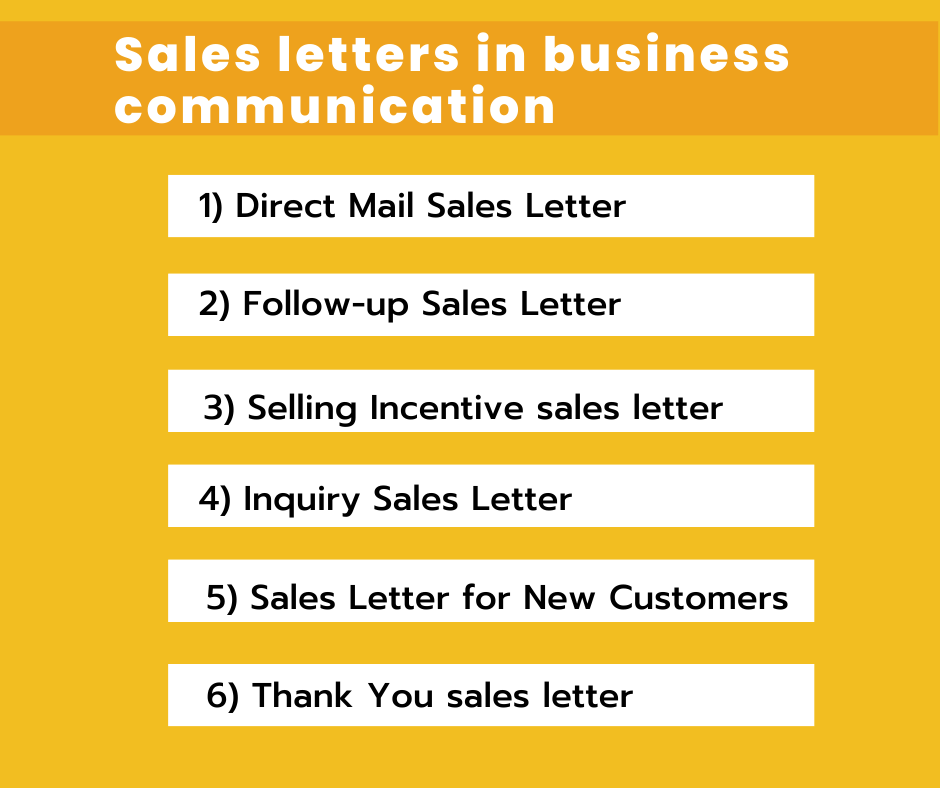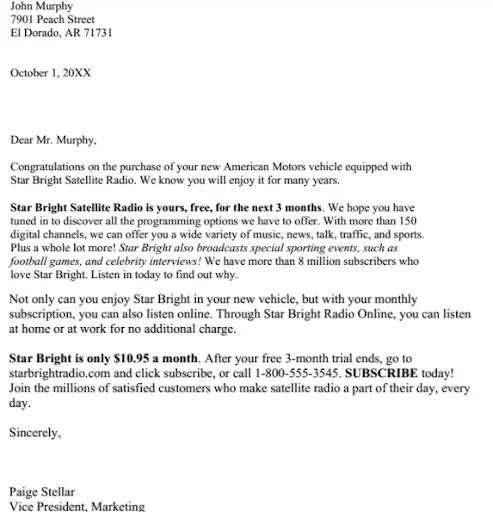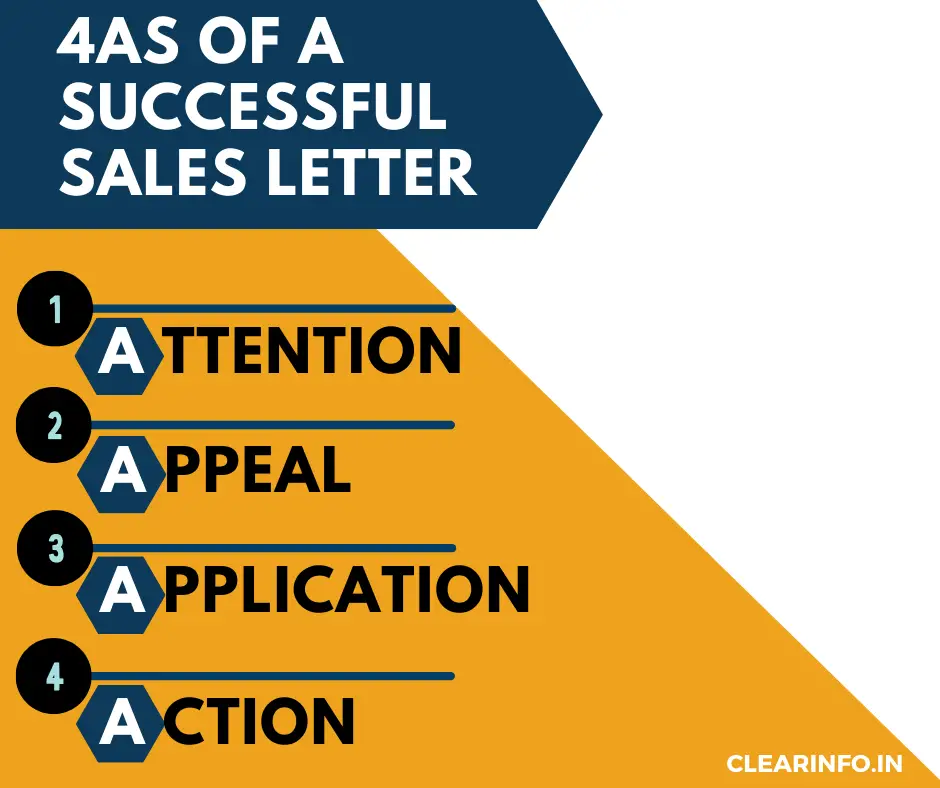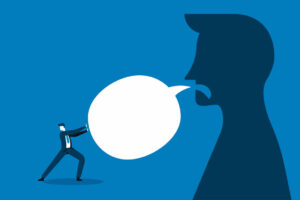Sales letters are a crucial aspect of business communication. They aim to promote products, services, or ideas to potential customers and encourage them to take action.
In this blog post, we’ll discuss everything you need to know about sales letters in business communication, and how to write effective sales letters with the help of examples and templates.
So whether you’re new to sales or a seasoned professional, this guide will provide you with the insights and strategies to create compelling sales letters that get results.
Definition of sales letter
“Sales letters are a form of direct mail designed to persuade the reader to take some specific action, such as purchasing a product or service, requesting more information, or signing up for a newsletter. – Bob Bly, author of “The Copywriter’s Handbook“
What is a sales letter in business communication?
A sales letter is a form of corporate correspondence aimed at convincing prospective clients to perform a specific action, such as buying a product, subscribing to a service, or seeking additional details.
It is a written message that is designed to sell a product or service and is usually sent directly to the target audience through channels such as direct mail or email.
Effective sales letters are written in a conversational tone, focus on the reader’s needs and interests, and use persuasive language and techniques to convince the reader to take action. They also often include testimonials or other social proof to build credibility and trust with the reader.
By crafting a well-written sales letter, businesses can effectively communicate the value of their products or services to potential customers and ultimately grow their bottom line.
Characteristics and features of sales letter
By incorporating these characteristics and features, a sales letter can efficiently convey the benefits of a product or service to prospective clients and motivate them to act accordingly.
1/ Attention-grabbing headline: A sales letter needs to have an attention-grabbing headline that immediately captures the reader’s attention and makes them want to keep reading.
2/ Introduction: To start off a sales letter, it is important to create an interesting introduction that builds a connection with the reader. The introduction should also present the product or service being provided and evoke a sense of urgency or requirement.
3/ Call to action: A sales letter should have a clear and persuasive call to action that encourages the reader to take a specific action, such as making a purchase or signing up for a service.
4/ Personalization: A sales letter should be personalized to the reader’s needs and interests, using language that resonates with them and makes them feel understood.
5/ Persuasive language: A sales letter should use persuasive language and psychological triggers to influence the reader’s emotions and decision-making process.
6/ Visuals: A sales letter may include visuals such as images and graphics to enhance its appeal and effectiveness.
7/ Formatting and design: A sales letter should have clear and easy-to-read formatting and design, with short paragraphs, bullet points, and bolded text to highlight key information.
Types of sales letters in business communication

1/ Direct Mail Sales Letter: This is the most common type of sales letter, which is sent directly to potential customers through mail or email. The purpose of a direct mail sales letter is to promote a product or service and persuade the reader to take a specific action, such as making a purchase or requesting more information.
2/ Follow-up Sales Letter: A follow-up sales letter is sent to those customers who have indicated their interest in a product or service previously but have not yet completed a purchase. The purpose of this type of letter is to encourage the customer to take action and make a purchase.
3/ Selling Incentive: A selling incentive sales letter is used to encourage customers to make a purchase by offering a special deal or incentive. The letter should highlight the value of the product or service and explain the incentive in detail.
4/ Inquiry Sales Letter: When a customer sends an inquiry about a product or service, an inquiry sales letter is sent in response. The main objective of this type of letter is to furnish additional information about the product or service and convince the customer to proceed with a purchase.
5/ Sales Letter for New Customers: A sales letter for new customers is sent to potential customers who have never purchased from the business before. The purpose of this type of letter is to introduce the business and its products or services and persuade the reader to make a purchase.
6/ Thank You sales letter: A thank you sales letter is used to show appreciation to customers for their business. The letter should express gratitude for their support and encourage continued purchase.
Functions of sales letters in business communication
Some of the key functions of sales letters in business communication:
- Promotion: The primary function of a sales letter is to promote a product or service to potential and existing customers.
- Persuasion: Sales letters are designed to persuade the reader to take a specific action, such as making a purchase, requesting more information, or attending an event.
- Informational: Sales letters can provide detailed information about a product or service, including its features, benefits, and pricing.
- Relationship Building: Sales letters have the potential to establish and sustain connections with potential and current customers.
- Follow-Up: Sales letters can be used as a follow-up to previous interactions with customers, such as inquiries or purchases.
Format of sales letter in business communication
The format of a sales letter in business communication includes the key elements that should be included in the letter to make it effective in achieving its goals.
1/ Heading: The heading of the sales letter should be attention-grabbing and informative.
2/ Introduction: The introduction should be brief and should highlight the main purpose of the sales letter.
3/ Body: The body of the sales letter should include the details of the product or service, its benefits, and its unique features.
4/ Testimonials: Including testimonials from satisfied customers can help to build trust and credibility. Incorporating genuine testimonials from actual customers is crucial.
5/ Call to action: The call to action is the most important part of the sales letter. It should be clear, concise, and compelling.
6/ Closing: The closing should be brief and should summarize the main points of the sales letter. It should also thank the reader for their time and consideration.
7/ Signature: The sales letter should be signed by the person who is responsible for the product or service being offered. The signature should be followed by the person’s name, title, and contact information.
Elements of sales letter in business communication
Writing a compelling sales letter requires careful planning and execution, as there are several elements that must be included in order to be effective. The 12 key elements of a sales letter include:
- Attention-grabbing headline – The headline should be attention-grabbing and compelling to encourage the reader to continue reading the letter.
- Opening statement – The opening statement should create interest and intrigue the reader.
- Establish credibility – It is essential to establish credibility by mentioning achievements, qualifications, or customer testimonials.
- Identify the problem – Identify the problem that the reader faces and show that you understand their situation.
- Offer a solution – Propose a solution to the issue and clarify how it resolves the problem.
- Provide benefits – Outline the benefits of the solution, making sure to focus on the benefits that matter most to the reader.
- Provide proof – Provide proof that the solution works, such as testimonials, case studies, or statistics.
- Create a sense of urgency – Create a sense of urgency by emphasizing what could happen if no action is taken or providing a limited-time offer.
- Make an irresistible offer – Make an offer that is too good to refuse, such as a discount, bonus, or guarantee.
- Call to action – Make sure to give the reader straightforward and precise instructions on what they should do next as a call to action.
- Overcome objections – Anticipate and overcome any objections the reader may have by addressing them in the letter.
- Close with a powerful P.S. – The P.S. should restate the main benefits, make an additional offer, or provide a final reason for the reader to take action.
How to write a sales letter in business communication
By following our step-by-step guide, you can write a sales letter that effectively communicates the benefits of your product or service and encourages your target audience to take action.
1/ Identifies Your Target Audience: Start by identifying the audience you want to target with your sales letter. This will help you tailor your message and writing style to their needs and preferences.
For Example: In case you are marketing a weight loss program, the group of individuals you may want to aim for are females aged 40 and above who are encountering difficulties in shedding weight.
2/ Define Your Unique Selling Proposition (USP): The Unique Selling Proposition (USP) of your product or service is what sets it apart and makes it superior compared to other offerings in the market. It should be clear, and concise, and highlight the benefits of your offering.
For Example: Your USP might be that your weight loss program is designed specifically for women over 40 and is based on the latest scientific research.
3/ Grab Attention with a Powerful Headline: Your headline should be attention-grabbing and compelling. It should address a specific problem or need that your target audience has, and promise a solution.
For Example: A powerful headline might read “Finally, A Weight Loss Program Designed Specifically for Women Over 40 That Works!”
4/ Introduce the Problem: After the headline, introduce the problem that your target audience is facing. This will help them relate to your message and feel like you understand their needs.
For Example: You might introduce the problem by saying “Are you tired of trying every weight loss program under the sun and not seeing any results?”
5/ Offer a Solution: Once you’ve introduced the problem, offer a solution that addresses the pain points of your target audience. Illustrate to them how your product or service has the ability to address their issue and improve their lives.
For Example: Your solution might be “Our weight loss program uses the latest scientific research to create a personalized plan that works for women over 40.”
6/ Provide Social Proof: Social proof is evidence that your product or service works. You can provide social proof by including testimonials, case studies, or statistics that support your claims.
For Example: You could include a testimonial from a woman over 40 who tried your weight loss program and lost 20 pounds in just 4 weeks.
7/ Create a Sense of Urgency: To encourage your target audience to take action, create a sense of urgency. This can be done by highlighting limited-time offers, scarcity of the product or service, or other time-sensitive incentives.
For Example: You might create a sense of urgency by offering a limited-time discount for those who sign up in the next 24 hours.
8/ Call to Action: Conclude your sales letter with a robust call to action that motivates your intended audience to carry out the desired action. Make it clear what you want them to do, and provide an easy way for them to take action.
For Example: Your call to action might say “Don’t wait any longer to achieve your weight loss goals. Sign up for our program today and start seeing results!”
9/ Proofread and Edit: Before dispatching your sales letter, review it thoroughly and implement any essential modifications. Ensure that your message is clear, concise, and error-free and fulfills your goal of business communication.
For Example: Before sending out your sales letter, make sure to proofread it carefully and edit any errors or typos.
Examples of sales letters in business communication
Example 1.1, represents a sales letter sent by J&L Cosmetics Pvt.Ltd to their customers for winning big prizes in return for sharing details of three referrals who use cosmetics products.

Example 2.1, Represent a sales letter by American Motor.Ltd shared with a new customer for post-purchase benefits. The letter includes an exclusive benefit of free 3 months subscription to Start Bright Satellite Radio along with a deal to continue the subscription for $10.95 a month after the free trial.

Template of sales letters in business communication
The following template denotes specific sections and elements of a sales letter with examples.

What are the 4As of a successful sales letter?
The 4A’s of a successful sales letter are Attention, Appeal, Application, and Action.

1/ Attention: The first and most important A’s of a successful sales letter is grabbing the reader’s attention. You can capture the reader’s attention and encourage them to continue reading by using an attractive headline or opening sentence.
2/ Appeal: After capturing the reader’s attention, it’s important to focus on their interests and needs. This involves emphasizing the advantages of your product or service and demonstrating how it can resolve the reader’s issues or enhance their life.
3/ Application: Once you have captured the reader’s interest, it’s important to showcase how your product or service operates in practical scenarios. This can be accomplished by presenting case studies, customer feedback, or instances of happy clients.
4/ Action: Finally, you need to provide a clear call to action that tells the reader what to do next. This could be anything from placing an order to signing up for a free trial, but it should be specific and easy to follow.
By including these four A’s in your sales letter, you can create a compelling message that captures the reader’s attention, appeals to their interests, shows them how your product or service works, and encourages them to take action.
How a sales letter is different from other letters
A sales letter is different from other letters in that its primary purpose is to persuade the reader to take a specific action, such as making a purchase or requesting more information. Unlike other letters, which may be more general in nature, sales letters are highly targeted and focused on a specific audience with the goal of generating a response.
Here is a table that outlines the differences between a sales letter and a purchase letter, a sales letter and an inquiry letter, and an application letter and a sales letter:
Sales Letter vs Purchase Letter
Aspect | Sales Letter | Purchase Letter |
Purpose | To persuade the recipient to buy a product or service. | To confirm a purchase and thank the customer for their business. |
Tone | Persuasive and enthusiastic. | Appreciative and Informative. |
Content | Product or service features and benefits, call to action. | Purchase confirmation details, thank you message, next steps. |
Examples | Direct mail marketing, email marketing, online ads. | Order confirmation emails, receipts. |
Sales Letter vs Inquiry Letter
Aspect | Sales Letter | Inquiry Letter |
Purpose | To persuade the recipient to buy a product or service. | To gather information and answer questions about a product or service. |
Tone | Persuasive and informative. | Helpful and informative. |
Content | Product or service features and benefits, call to action. | Request for information or clarification, answer to inquiry questions. |
Examples | Direct mail marketing, email marketing, online ads. | Customer service response to an inquiry, website contact forms. |
Sales Letter vs Application Letter
Aspect | Sales Letter | Application Letter |
Purpose | To persuade the recipient to buy a product or service. | Direct mail marketing, email marketing, online ads. |
Tone | Persuasive and enthusiastic. | Professional and informative. |
Content | Product or service features and benefits, call to action. | Professional introduction, qualifications and experience, request for consideration. |
Examples | Direct mail marketing, email marketing, online ads. | Job application letters, college admission letters. |
Sales Letter vs Order Letter
Aspect | Sales Letter | Order Letter |
Nature | Persuasive in nature, aiming to convince the recipient to make a purchase or take a desired action. | Transactional in nature, focused on placing an order for a specific product or service. |
Content Focus | Emphasizes product features, benefits, and promotional offers to entice the recipient to buy. | Provides specific details about the desired product or service, such as quantity, specifications, and delivery instructions. |
Target Audience | Typically addresses a broad audience, including potential customers who may not have expressed prior interest. | Usually directed to an established customer or prospect who has expressed an intent to purchase. |
Style and Tone | May use storytelling, emotional appeals, and marketing techniques to create a desire for the product or service. | Typically straightforward and concise, focusing on providing the necessary information for the transaction to take place. |
This table highlights the key points of differentiation between a sales letter and an order letter, helping to illustrate the distinct purposes and characteristics of each.
Further Reading: Order letter in business communication
What is meant by direct letters and indirect letters in business communication
In business communication, direct letters and indirect letters refer to the two types of communication styles used in writing letters.
Direct letters are straightforward and to the point. They are used to deliver a message or request in a clear and concise manner. Direct letters usually have a clear objective and are meant to achieve a specific purpose, such as making a sale or resolving a complaint.
On the other hand, indirect letters are written in a more tactful and diplomatic manner. They are often used to make a request or convey a message in a way that is less direct and confrontational.
Sales promotion letters in business communication
Sales promotion letters are a type of business communication that is used to promote a product or service. They are typically sent to existing or potential customers to generate interest, increase sales, and promote brand awareness.
Effective communication is crucial for the success of any business, and sales promotion letters play an important role in communicating with customers. They provide a direct and personalized way to reach out to customers and offer them incentives to purchase products or services.
The importance of business communication cannot be overstated, especially when it comes to sales. Without effective communication, it would be difficult for businesses to promote their products or services, generate interest, and increase sales.
Sales promotion letters can be sent via email, direct mail, or other forms of advertising and are an effective way to increase sales and grow a business.
Common mistakes to avoid while writing sales letters
- Failing to Identify the target audience: A sales letter is meant to persuade a specific audience to take a specific action. If you don’t recognize your intended audience, your sales pitch may be generic and ineffective.
- Not including a clear call-to-action: Your sales letter should include a clear and specific call-to-action that prompts your reader to take the desired action. Without a call to action, your reader may be unsure of what to do next.
- Using a formal tone: A sales letter should be written in a conversational tone that engages the reader and builds a connection. Avoid using overly formal language that can make your letter sound cold and impersonal.
- Making exaggerated claims: While it’s important to highlight the benefits of your product or service, making exaggerated claims can make your sales letter seem insincere or even dishonest. Stick to the facts and avoid hype.
- Being too long-winded: A sales letter should be concise and to the point. Long, rambling paragraphs can make your letter seem overwhelming and difficult to read.
- Failing to address objections: Anticipate and address any objections your reader may have in your sales letter. If you don’t address these objections, your reader may be hesitant to take the desired action.
Tips for writing effective sales letters
1/ Present your letter professionally: Utilize high-quality paper, incorporate your business letterhead, and select good-quality envelopes. This will help your letter stand out and convey a sense of professionalism.
2/ Format for skim reading: Use headlines, sub-headlines, bullets, and bold text to make your letter easy to scan. Vary paragraph length and use bold text or underlines to highlight important points.
3/ Make it as easy as possible to respond: Include pre-paid envelopes or forms that are easy to fill out, offer toll-free numbers, and provide one or two contact options, allowing the recipient to choose the most suitable option.
4/ Use a casual, conversational tone: People respond better to conversation than to a formal tone. Write to the reader as though they’re a family member or friend to build trust and rapport.
5/ Use storytelling to engage the reader: Narrate a brief story that your reader can relate to, start with an engaging customer testimonial, and always link the story back to your offer.
6/ Tell them what their problem is, and offer the solution: Demonstrate that you comprehend the problem or requirement of the recipient and explain how your offer addresses the issue or satisfies the requirement.
7/ Build instant trust by establishing credibility: Tell your reader who your company is and why you’re worth their time. Use testimonials, awards, and other accolades to back up your claims, but make sure to do it sparingly and keep the letter customer-focused.
8/ Make use of the Post Script: Use the post-script to restate your offer or strong guarantee, remind your reader of the most important benefit, restate the urgency or scarcity of the offer, or offer a bonus if they act now.
Frequently asked questions
Q1: What is a sales report?
Ans: A sales report is a document that provides an overview of a company’s sales performance during a specific period of time. It includes data such as the number of units sold, revenue generated, and profit margins.
Q2: What is a sales letter form of communication?
Ans: A sales letter is a form of written communication that is used to persuade potential customers to purchase a product or service. It typically includes information about the product or service being sold, as well as its benefits and features.
Q3: What type of letter is a sales letter?
Ans: A sales letter is a type of business letter that is used to promote a product or service. It is typically addressed to potential customers and is designed to persuade them to make a purchase.
Q4: What are sales in business communication?
Ans: Sales in business communication refers to the process of selling a product or service to a customer. It involves using various communication techniques, such as sales letters, phone calls, or in-person meetings, to persuade potential customers to make a purchase. Negotiation skills in business communication play a key role in the sales process as they enable sales professionals to communicate effectively with customers, understand their needs, and negotiate deals that benefit both parties.



